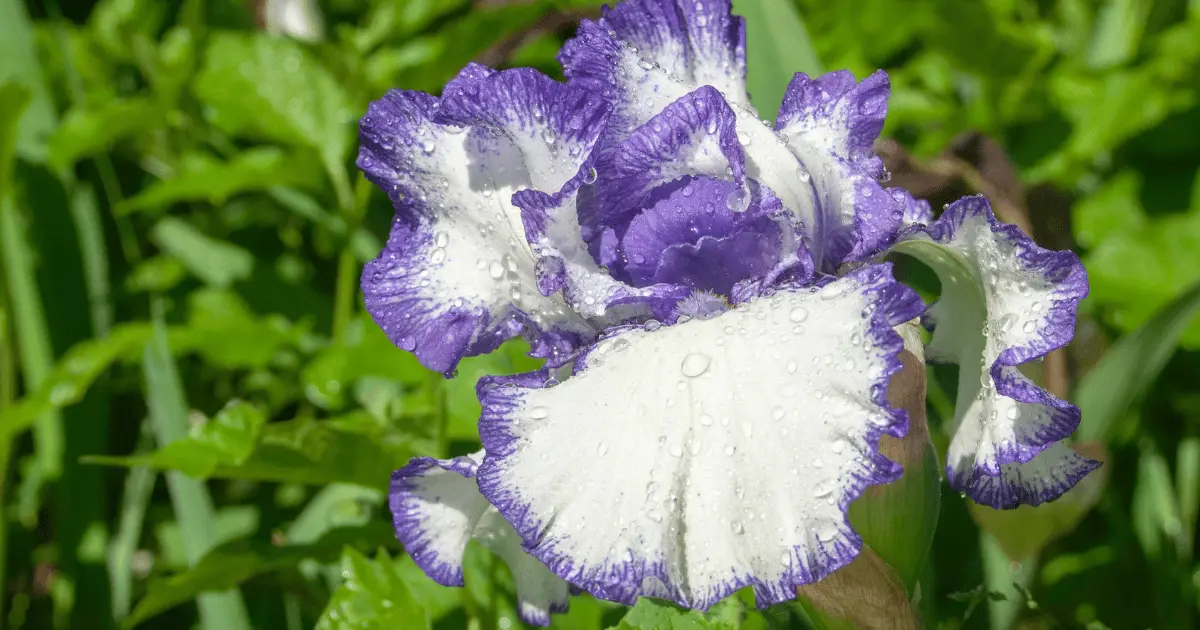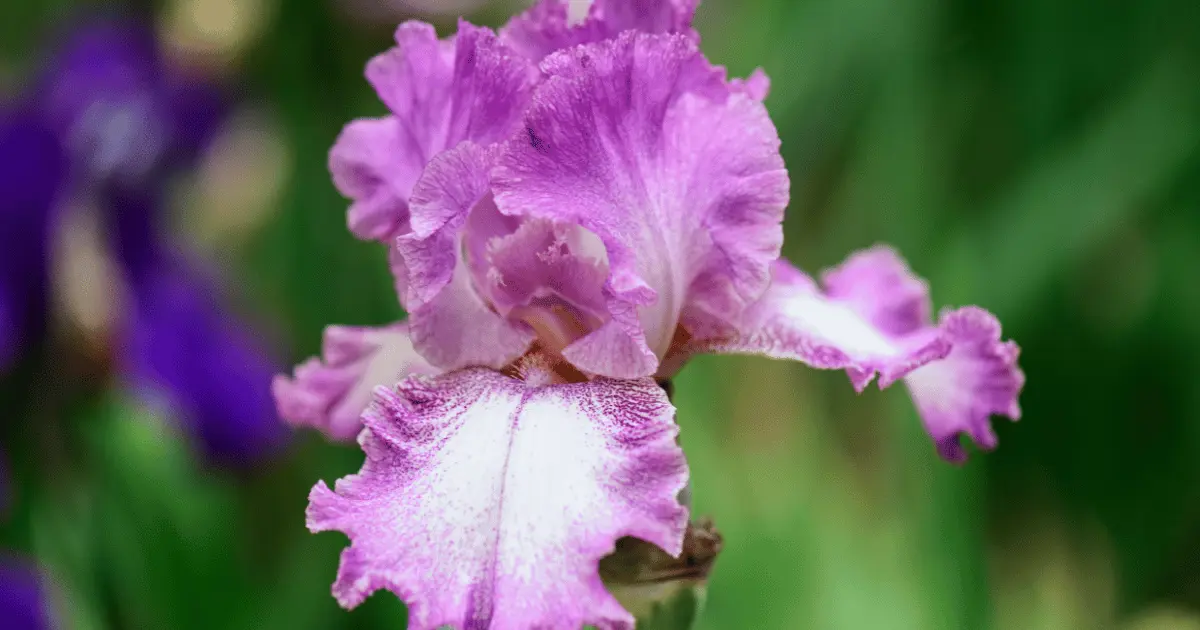The variegated iris is a beautiful flower that blooms in early spring and comes in several colors. They add beauty to the garden while providing nectar to bees and other beneficial insects, so growing them effectively and caring for them properly is important.
These plants are used in borders and rock gardens and are grown from rhizomes (called corms). They are low-maintenance, easy to grow, don’t require a lot of water, and thrive in partial shade or full sunlight.
You’ll need to follow certain steps to grow and care for this unique plant effectively. In this guide, we’ll go over these steps in detail to help you get started.
What is a Variegated Iris?

A variegated iris is a unique flower with distinctive streaks on the petals and colorful patterns, including yellow, pink, purple, blue, white, orange, and lavender. It’s a hardy, adaptable plant and popular for its bright and vibrant blooms.
A variegated iris is an excellent choice if you want to add bright and beautiful colors to your garden. Its unique patterned petals will surely make your garden stand out! However, it’s important to note that variegated iris needs to be taken care of properly to ensure it grows and blooms well.
Where to Plant Variegated Iris
Variegated iris (Iris pallida variegata) is an attractive and hardy perennial flower that adds color and texture to your garden. When planted in the right conditions, it can thrive for years and come back year after year. But before planting these stunning blooms, it’s important to understand where to plant them.
Planting variegated iris in the right location is incredibly important, and it is preferable if the soil is well-drained, moist, and exposed to full sun to partial shade. The best way to ensure your plants get enough light is to select a spot with direct sunlight for six hours each day. Keep in mind too much sun can burn the leaves of the plant, so be sure to provide adequate shade if needed.
Placing variegated iris around other perennials or annuals with similar needs will help reduce competition and give them room to grow without competing with other plants. Also, space the plants 12-18 inches apart to ensure good air circulation.
Growing Conditions and Requirements
Soil
The variegated iris prefers rich, loose, well-drained soil, although it can also thrive in dry soil. Growing conditions are best in neutral to slightly acidic soil with 6.0 and 7.0 pH levels. You can also add sulfur to improve the alkalinity in the soil and lime if the soil is too acidic.
Sunlight
The variegated iris prefers direct sunshine. Although it requires more than 6 hours of sunlight daily, it thrives in landscapes with no shade. It can also thrive in partially shaded areas, although the quality of its disease resistance and blooms could decrease. Some varieties of iris can flourish in low-light conditions and the shadows of other plants.
Water and Hardiness
The Iris plant is mostly grown in temperate regions of the Northern Hemisphere. Except for a few tiny species that need straw or bark to protect their roots in cold places, the bulk of its iris species is hardy. Water requirements vary across Iris species as well, and some Iris species like moist conditions, and some can even flourish in water.
Variegated irises are grown from rhizomes (called corms), and the steps are as follows:
Propagating Variegated Iris

- Choose a location that receives full sun or partial shade. As well as being well-drained, the soil should also be rich in organic matter.
- Mix the fertilizer evenly.
- Cut the leaves on the rhizomes to about 15cm in length to increase survival rates and decrease water evaporation.
- Plant the rhizomes two inches deep with the soil lightly covered.
- Keep the rhizomes moist and water them once a week during the growing season.
- It is also important to mulch your variegated iris to ensure the rhizomes stay moist and protected. You can use organic mulch such as wood chips or bark. Make sure to keep the mulch away from the plant’s crown, as it can cause rot.
You can also divide your variegated iris every few years to promote healthy growth. In early spring, dig up the rhizomes and gently separate them into clumps of two or three plants. Then replant them in their new location and keep them watered regularly.
Finally, prune your variegated iris in late winter or early spring to help promote better blooms. Cut back any dead or damaged leaves, stems, and flower heads. This will help encourage new growth and keep your Variegated Iris looking its best!
How to Care for Variegated Iris

Caring for variegated irises is easy as long as you know a few basics. For variegated irises to thrive, follow these tips:
- Location – Irises with variegated colors prefer a sunny spot with at least six hours of sunlight each day. They can also tolerate partial shade but may not bloom as profusely.
- Soil – Variegated irises require soil that drains well and has lots of organic matter. Amend the soil with peat moss, compost, or manure before planting.
- Watering – Variegated irises need regular watering but do not like to be in soggy soil. If the leaves start to yellow or wilt, water more frequently.
- Fertilizer – Variegated irises don’t need much fertilizer. Apply a balanced 10-10-10 fertilizer once or twice a year in early spring and late summer. You can also water the plant after fertilizing to help the root absorb the fertilizer faster.
- Pruning – Pruning is important for keeping your variegated irises healthy and blooming. After flowering has finished, trim off any dead or damaged stems. You can go further by cutting off the stalks after blooming to increase nutrition consumption.
- Mulching – You can help retain moisture and prevent weed growth by mulching your variegated iris’ base.
- Harvesting – Iris flowers of different colors can be harvested for decorations and bouquets. Choose flowers that aren’t completely blossomed and cut them from the stem base diagonally using a pair of gardening scissors. To minimize dehydration, quickly place the flower in a vase filled with clean water.
Following these simple tips will help keep your variegated irises healthy and make them flourish in your garden.
Troubleshooting
The variegated iris is a beautiful flower that can bring a splash of color and texture to any garden. However, caring for them can sometimes be tricky. This section will cover some common problems you may experience while growing and caring for your variegated iris plants. One issue might arise from transplanting the plant too soon.
The plant needs to be transplanted into a pot with good drainage holes to prevent root rot or rotting. If the plant were in a pot without drainage holes, you would need to wait until the potting soil has dried out before moving it again.
Once it’s been transplanted into a new pot, use perlite as an amendment, so it doesn’t become waterlogged or overwatered again. Another problem could occur if there’s no wind flow around the plant due to planting it too deeply in the shade or next to other flowers or foliage, which prevents air from flowing freely around its leaves.
Pests and Diseases of Variegated Iris
Taking care of your variegated iris ensures they thrive in your garden. Although these plants are relatively easy to care for, they are susceptible to certain diseases and pests. Understanding how to identify and prevent these issues is essential if you want your variegated irises to look their best.
The most common pests affecting variegated irises include aphids, spider mites, thrips, leafhoppers, and slugs. Besides damaging the plants’ leaves, flowers, and stems, these pests feed on the plant’s sap. You can get rid of these pests using horticultural oil or insecticidal soap; both products are safe for plants and effective.
In addition to pest issues, fungal and bacterial diseases can also affect variegated irises, leading to spots on the leaves, wilting, or even root rot. The best way to prevent these diseases is by providing good air circulation and avoiding overcrowding. Ensure your plant has moist soil that is not soggy, and remove any dead leaves or fallen flowers. If you notice signs of disease on your variegated iris, you should contact a local expert for advice on how to proceed.
Asides from dealing with pests and diseases, regular inspections of the plants and taking proper precautions will help keep them looking beautiful for many years to come!
In conclusion, variegated irises are an absolutely beautiful flower that is relatively easy to care for. To keep them healthy and vibrant, fertilize regularly, remove any dead foliage, and keep them out of standing water. If you follow the simple steps mentioned above, you’ll have a thriving and colorful garden of Variegated Iris for years to come.
